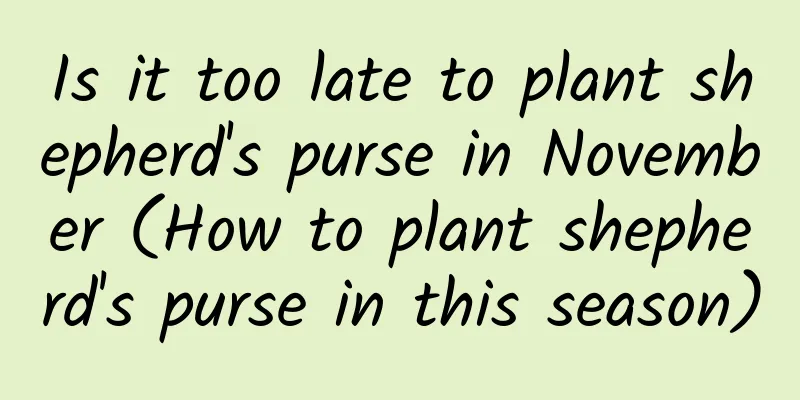Is it too late to plant shepherd's purse in November (How to plant shepherd's purse in this season)

|
The light and temperature in autumn are more suitable for the growth of shepherd's purse. The growing period is longer, it can be harvested multiple times, the yield is high, it is not easy to bolt, and the quality is good. It is the main cultivation season for shepherd's purse. It can be sown from late July to early September, and harvested from late September to mid-to-late October. Late autumn shepherd's purse sown in mid-September can be put on the market on New Year's Day or Spring Festival. Greenhouse cultivation is sown from mid-to-late October to early November. Shepherd's purse planting technology1. Variety selectionFor early sowing, it is better to choose broad-leaf shepherd's purse seeds, and for late sowing, it is better to choose loose-leaf shepherd's purse seeds. 2. Site selection and land preparationChoose fertile and loose loam. Before plowing, apply 2000-3000 kg of fully decomposed organic fertilizer and 30-50 kg of compound fertilizer per mu. Spread the fertilizer evenly on the surface and then plow. Generally, the plowing depth is 15 cm. Make ridges after fine harrowing and leveling. 3. Seed treatmentUnder natural conditions, shepherd's purse seeds have a dormant period after maturity and germinate in autumn. The seeds should generally be processed, either by soil sedimentation or in a low-temperature refrigerator at 2~7°C. The soil deposition method is to place the seeds in a pot, cover with river mud, place in a cool place, take out and sow in late July, and the seeds will emerge after 1 to 5 days. For low temperature treatment, in addition to using a refrigerator, you can also mix the seeds with fine sand, place them at 2 to 10°C, sow them after 7 to 9 days, and the seeds will emerge in 4 to 5 days. 4. Sow at the right timeIf sowing is done before August, the weather will be hot, there will be a lot of rain, the ground will easily dry out, and it will be difficult for the seedlings to emerge, which will increase the risk; if sowing is done after mid-September, the weather will be low after germination and the yield will be low. In North China, sowing should not be done later than mid-September. If sowing is done from July to early August, the germination rate is poor, and the seed rate is 2 kg per mu. If sowing is done in early September, the germination rate is high due to cooler weather, and the seed rate is about 1 kg per mu. To prevent high temperature and drought from affecting germination, shepherd's purse sown in early autumn can be covered with shade nets, corn stalks, etc. after sowing to reduce temperature, retain moisture, prevent rain and sun, and remove the covering in time after germination. 5. Water in timeThe yield of early autumn sowing shepherd's purse and the early or late harvest are closely related to timely watering. Before the seedlings emerge, water them continuously, usually with a watering can, once in the morning and once in the evening every day to avoid flooding. After the seedlings emerge, spray water once a day. Do not water too much each time, just keep the soil moist. Shepherd's purse needs to be watered more frequently. If it is cultivated in a vegetable field with sprinkler irrigation conditions, the yield will be high and the quality will be good. Shepherd's purse sown in late autumn should only be watered lightly, frequently and coolly, and watered in the morning and evening when the dew has not dried. 6. Reasonable topdressingAutumn-sown shepherd's purse has a long growing period and generally requires four top dressings. Seedlings generally emerge three days after autumn sowing, and top dressing can be done when two true leaves appear. The second top dressing is done 7 to 10 days before harvest, and top dressing is done once every harvest thereafter. Apply topdressing once before winter (late November to early December) and in February to March of the following year. Apply 1500 to 2000 kg of thin and well-rotted manure per mu each time. Fertilization should follow the principle of "frequent, light and sparse". 7. Prevent cold and frostFor late autumn sowing, you must consider cold and frost protection. Although shepherd's purse is a cold-resistant crop, it will also suffer frost damage when the temperature is below 5°C in severe winter. The frozen leaves will turn purple and yellow and eventually fall off. Therefore, you can adopt appropriate irrigation before the cold wave comes, and irrigate on sunny days after freezing. Before freezing, you can cover the fields with straw bags, old films, and melon and bean vines, and press them tightly with mud or bricks on all sides. This can not only prevent cold, but also allow the plants to grow well. Fertilizer can be applied once 3-4 days before covering. Generally, 10-15 days after covering, the shepherd's purse leaves turn green and stretch upward, and can be harvested and put on the market at once. If harvested and put on the market in batches, a small arch shed can be built or covered with film. Pay attention to temperature management when cultivating in greenhouses. Start covering the greenhouse with film in late October to early November. Provide proper ventilation in the early stage and strengthen insulation in the later stage. When a cold wave comes, use shade nets, non-woven fabrics, etc. to cover the floating surface at night, and pay attention to uncovering to prevent excessive growth and bolting. |
Recommend
When to apply fertilizer to citrus trees to strengthen their fruit (the best time to fertilize fruit-bearing citrus)
1. When is the best time to apply citrus fruit-en...
What to do if lavender roots rot
1. Replace the soil Reason: Lavender roots are no...
How to save a dried azalea? Can a dried azalea survive?
1. Can you survive? If only the upper part of the...
When does the peach blossom bloom? Peach blossom pictures
1. Opening hours Peach blossoms usually bloom in ...
What is watercress?
What is watercress? Watercress is a vegetable tha...
What to do if the leaves of pine red plum dry up
Burns When growing pine red plum, the reason for ...
Lettuce seed germination method
If the lettuce is germinated, the utilization rat...
Why are the leaves of the four-season plum wilting?
1. The temperature is too low 1. Specific reason:...
Phalaenopsis price, Phalaenopsis pictures
1. Phalaenopsis price The price of Phalaenopsis o...
How to grow Clivia, cultivation methods and precautions
1. How to grow Clivia 1. Temperature: Clivia is a...
How to propagate figs
Cutting propagation Cuttings are usually carried ...
What is the prospect of growing Isatis indigotica in 2022 (Isatis indigotica market price forecast analysis)
What is the market trend of Isatis indigotica in ...
What kind of plant is Victoria regia? Is it an aquatic plant?
1. What kind of plant is Jade Lotus? This type of...
Disease and Pest Control of Hosta
Hosta sunburn symptom Hosta prefers semi-shaded a...
When is the best time to sow asparagus fern
Suitable time for planting asparagus fern Asparag...









